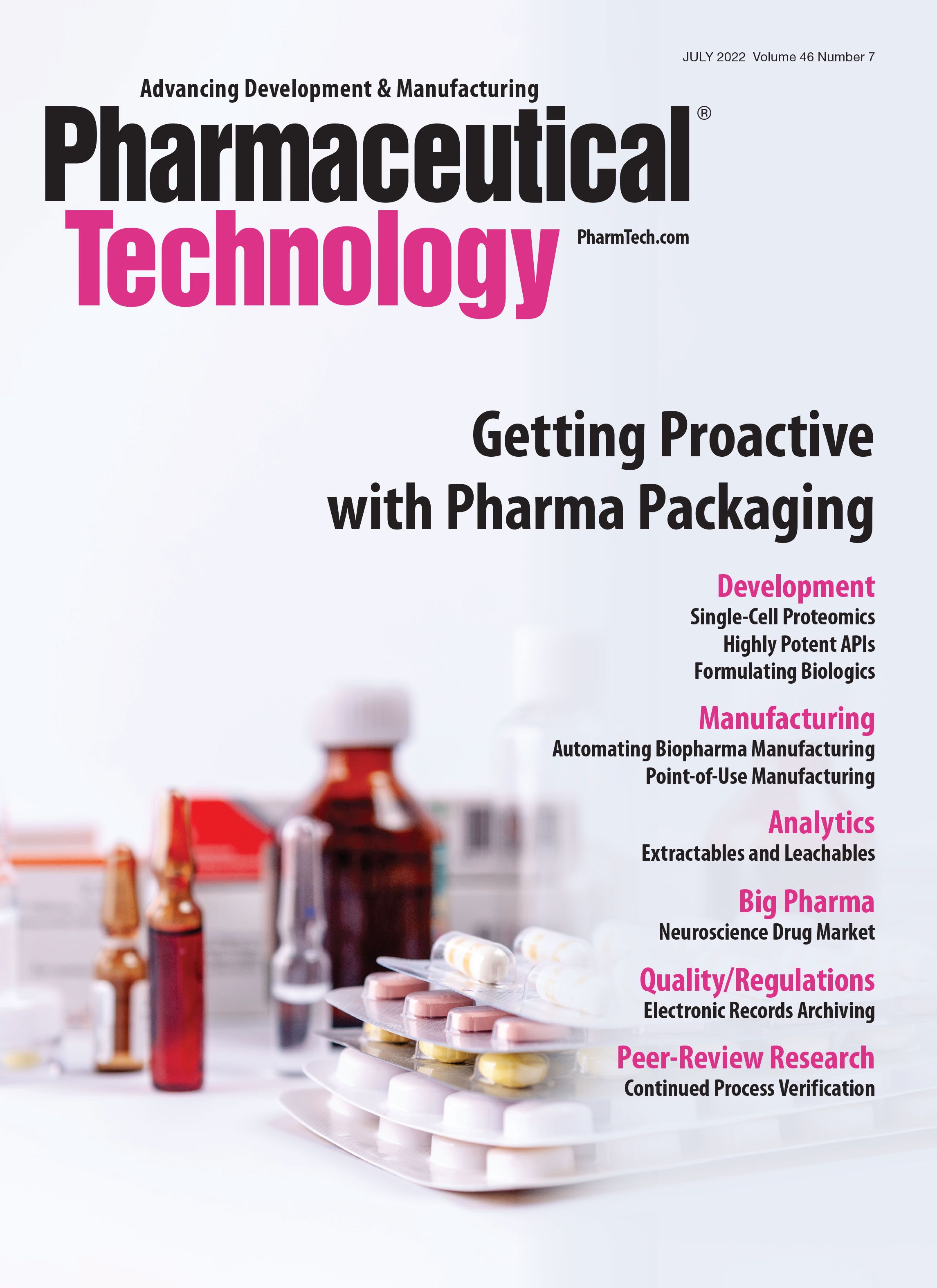Material Management and the Impact on Extractables and Leachables
By understanding potential material change, the impact on patient safety can be understood and mitigated.
AdobeStock_177632167_Monster Ztudio

In the world of extractables and leachables (E&L), one thing that is nearly guaranteed is that change will happen with the materials used in the container closure system. Management of these changes is the responsibility of the drug product manufacturers.
Changes can be external, where the supplier changes manufacturing, information, or availability of a component. It can also be internal, where the drug manufacturer changes the validated manufacturing process or use of the component. External changes can vary from small manufacturing changes that are within manufacturing tolerances, such as in-process changes to time, temperature, etc., to larger manufacturing changes, such as a site change. Larger or more significant external changes can happen, such as a change in the formulation of the material (e.g., additive change) or stopping the manufacture of that particular material. Internal changes can include changes in contact time with a single-use container or the addition of a second supplier of the material components. These internal or external changes are not an exhaustive list but give a flavor of potential changes that may occur.
Understanding changes
In the Guidance for Industry: Changes to an Approved NDA or ANDA, FDA details recommendations to holders of new drug applications and abbreviated new drug applications, specifically on post-approval changes for drugs other than specific biotechnology and specific synthetic biological products (1). This guidance provides recommendations for post-approval changes in:
- Components and composition
- Manufacturing sites
- Manufacturing process
- Specifications
- Container closure system
- Labeling
- Miscellaneous changes
- Related changes (1).
According to this guidance (1), these changes might require post-approval in accordance with section 506A of the US Federal Food, Drug, and Cosmetic Act and Code of Federal Regulations (CFR) Title 21 s.314.70 (21 CFR 314.70) (2).
These documents outline the classification of a change (minor to major) and the regulatory requirements for handling these different change levels.
A minor change, according to FDA guidance, has “minimal potential to have an adverse effect on the identity, strength, quality, purity or potency of the drug product as these factors may relate to the safety or effectiveness of the drug product” (1).
In CFR Title 21, FDA instructs that the applicant must describe minor changes in the next annual report (2).
In an FDA guidance, a moderate change has “a moderate potential to have an adverse effect on the identity, strength, quality, purity or potency of the drug product as these factors may relate to the safety or effectiveness of the drug product” (1).
Commonly, these changes require that the drug manufacturer submit a supplement called Changes Being Effected in 30 Days (CBE-30). This supplement will include information describing the effects of the change. The drug manufacturer must wait 30 days after submission of the CBE-30 before implementing the change and must not implement the change if FDA responds with a request for more information to support the change.
Finally, FDA states that a major change has “a substantial potential to have an adverse effect on the identity, strength, quality, purity or potency of a drug product as these factors may relate to the safety or effectiveness of the drug product” (1).
These changes require that the drug manufacturer submit a prior approval supplement (PAS). The drug manufacturer must wait for FDA approval of the PAS before implementing the change.
Historic material changes
Material changes can have an impact on both product quality and the patient. There are a few well-known examples. The most quoted example was during the period of 1998–2002 when there was an increase in the incidence of antibody-positive pure red cell aplasia in patients receiving subcutaneous administration of EPREX (epoetinum alfa). At the time, two simultaneous changes happened. Firstly, the drug product formulation was changed to include polysorbate 80; and secondly, the coated stopper was replaced with an uncoated one (3). Additional compounds were observed in the leachable analysis of the new product. However, these leachable compounds were only observed when the product contained both polysorbate 80 and used the uncoated stopper, but these new leachable species were not observed when both were used separately.
In the early days of E&L testing, prior to appropriate change management, a change in the composition of the material was first known upon a test being conducted and a new extractable profile—or worse, a leachable profile was observed. Because leachables typically take time to form, this observation implied that a change happened, potentially, many months prior. This first E&L observation was also before the seminal document by the Product Quality Research Institute on Safety Thresholds and Best Practices for Extractables and Leachables in Orally Inhaled and Nasal Drug Products in 2006(4). This recommendation has set the scene for E&L testing in the years following. Despite this being only a recommendation, it was authored with FDA and Health Canada involvement.
Inhalation aerosols and sprays
Inhalation aerosols and sprays are deemed to have the highest likelihood of packaging component-dosage form interaction and the highest degree of concern based on the route of administration. As such, it is not too surprising that most of the early work on regulatory requirements focused on orally-inhaled and nasal drug products. It was groups such as the International Pharmaceutical Aerosol Consortium on Regulation & Science that initiated and built on supply chain interaction and understanding. The group’s initial work was published in the 2011 paper, “Recommended Baseline Requirements for Materials Used in Orally Inhaled and Nasal Drug Products (OINDP),” and a subsequent update was provided in 2017 (5).
It is also not necessarily the direct container closure system that can cause problems with patient safety and product quality. Around 2010, there were product recalls due to the wooden pallets on which product boxes were stored. A biocide used to treat the pallets had degraded, and one of its degradants—2,4,6-tribromoanisole (TBA) migrated into the products and tainted them. The TBA has a very low odor threshold, meaning that very small amounts can cause unpleasant musty and moldy aromas. A total of 55 million bottles of Tylenol were recalled in a six-month period in 2010 due to this issue (6). This incident resulted in several pharmaceutical companies ceasing the use of wooden pallets to transport products.
Single-use systems
Material changes can have potentially more impact on biologics that are manufactured with single-use systems. A particular biologic can be impacted by small amounts of leachable species. The exact mechanism of this is unknown. The most quoted example of this is “Identification of a Leachable Compound Detrimental to Cell Growth in Single-Use Bioprocess Containers,” a research article by Amgen (7). Researchers found that a trace amount of a breakdown product of a common antioxidant, Irgafos 168, was detrimental to cell growth. The level of this antioxidant was far lower than typical screening levels that would be required due to typical toxicological concerns.
Biologics
Additionally, it is well known that biologics/peptides are at significant risk from reaction with E&L. The biggest risk relates to covalent bond formation for which there are several well-known examples. One example includes the reaction of the common leachable from halo butyl rubbers. This leachable, the C13 halogenated aliphatic, can undergo an SN2 reaction with the protein, forming a new chemical species.
Acrylic acid, which can be used as the glue in syringes, is known to modify peptides either through the lysine side chain or through histidine by a Michael addition reaction. The level of modification was reported at 0.2–5% of a range of proteins (8).
Other reactions can happen, such as the Schiff base reaction of breakdown products of butylated hydroxy toluene and acylation reactions (9). It is often observed when materials undergo sterilization, which causes additives, such as antioxidants, to degrade and form potential reaction products. It is important to mention that if these antioxidants were not present, the polymer would very rapidly degrade, and the container closure would no longer be useable. It is, therefore, likely that any changes with materials used with biologics could have a more significant impact on patient safety (either because of safety or efficacy) than those with small molecules or medical devices. Further work is in progress to help identify potential issues with common leachables.
The future
Cumulatively, this leads to the importance of understanding the materials used in container closure systems and manufacturing systems for biologics and peptides to avoid potential issues—rather than solving them after the event. Having appropriate data on materials used for biologics/peptides can assist in reducing the risk of interaction with leachables. Appropriate data includes extractable data obtained from studies that are undertaken on sterilized/treated materials under appropriate extraction conditions (where extractables can be correlated with leachables) with sufficient sensitivity.
What does the future hold? As mentioned at the start of the article, change is inevitable, but there are some potential new changes coming. There is a push for greener materials and the reduction of single-use plastics. Will the additive packages change to allow polymers to be depolymerized back to the starting monomers so they can potentially be used as virgin materials rather than recycled? It is through an understanding of the likelihood and impact of change that potential patient safety can be understood and mitigated.
References
1. FDA, Guidance for Industry, Changes to an Approved NDA or ANDA (CDER, April 2004).
2. CFR Title 21, Part 314, Vol. 5, Subchapter D (Government Printing Office, Washington, DC), accessed June 2022.
3. K. Boven et al., Kidney International 67 (6) 2346–2353 (2005).
4. PQRI, Safety Thresholds and Best Practices for Extractables and Leachables in Orally Inhaled and Nasal Drug Products (Sept. 8, 2006).
5. IPAC-RS, “Recommended Baseline Requirements for Materials Used in Orally Inhaled and Nasal Drug Products (OINDP),” ipacrs.org (Feb. 9, 2017).
6. G. Miller and E. Teichert, “The Battered Brand: A Tylenol Recall Timeline,” fiercepharma.com (Jan. 18, 2011).
7. M. Hammond et al., PDA JPST 67 (2) 123–134 (2013).
8. D. Liu et al., PDA JPST 66 (1) 12–9 (2012).
9. K. Li et al., PDA JPST 69 (5) 590–619 (October 2015).
About the author
Andrew Feilden is the European E&L strategic director for Element.
Article details
Pharmaceutical Technology
Volume 46, Number 7
July 2022
Pages: 48–51
Citation
When referring to this article, please cite it as A. Feilden, “Material Management and the Impact on Extractables and Leachables," Pharmaceutical Technology 46 (7) 48–51 (2022).
